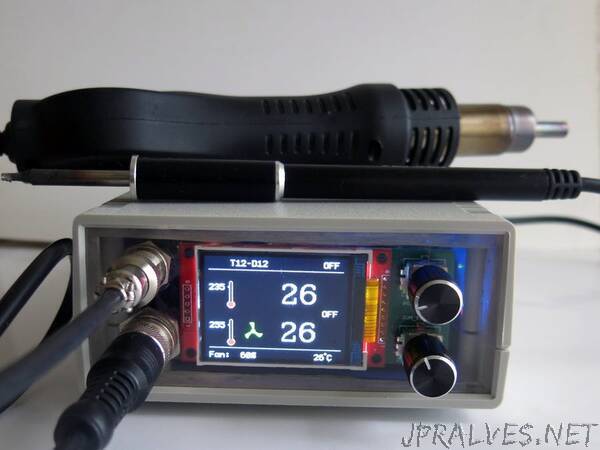
“Soldering station supported Hakko T12 tips and rework Hot Air Gun 858D using color TFT ili9341 display.
This is a third release of combined soldering iron controller for Hakko T12 tips and 858D rework station based on STM32 micro controller. This time the oled display was replaced by ili9341 TFT one with SPI interface. There are several display variants (2.2”, 2.4”, 2.8” or 3.2”), in the market, so you can chose the one that satisfies your requirements, I used 2.2” display. The touch screen feature is not used in this project, but you can use display with touch screen panel.
The soldering controller supports using soldering iron and Hot Air Gun at the same time. In the main mode, you can activate any device or activate both devices simultaneously or turn them off. As soosn as the display resolution is higher than oled display, the information of both devices can be displayed on the main screen.
To simplify managing both devices simultaneously the controller implements two rotary encoders. The upper encoder manages the soldering iron and the lower one manages the hot air gun and activates main menu. The automatic mode switch that turn the Hot Air Gun off is still optional an can be plased on the back panel, like mine.
Let’s get started
This project has several features:
- The controller allows managing Hot Air Gun and soldering iron independently. Two independednt rotary encoders siplifies this type of managind devices. The reed switch of the Hakko 858D Hot Air Gun handle used to activate rework capability.
- The soldering iron can be automatically switched off or keep working depending on configuration parameters in the main menu.
- Optional automatic mode switch can be used when you do not connect the Hot Air Gun to the controller to switch the Hot Air Gun for sure. The auto switch connected in parallel with the reed switch of Hot Air Gun.
- Hot Air Gun is powered by a whole sine half-period voltage peaks and do not disturb the AC outlet.
- The controller checks the soldering tip is connected by testing a small amount of current through the tip. The allows to change the soldering tip. When soldering iron is powered off and tip removed from handle, the ‘change tip’ procedure would be activated.
- The controller checks the Hot Air Gun is connected and its fan is working properly before applying power to the Hot Air Gun heater. This increase the safety of the controller.
- The controller would keep the Hot Air Gun fan working on low power until it become cold. Optional power switch can be used to automaticslly turn-off the controller after the Hot Air Gun become cold. This allows you to lieave your workplace immediately and guarantee the Hot Air Gun will be cooled safely.
- The fan speed of the Hot Air gun is managed automatically as soon it is powered off. This increase the cooling process and ensure the hot air does not harm your workplace environment.
- The controller uses ambient temperature sensor inside the FX9501 handle to correct the tip temperature measured by the soldering tip thermo couple.
- The controller supports individual calibration of the tip by four reference points, 200, 260, 330 and 400 degrees Celsius.
- The controller supports calibration of Hot Air Gun by four reference points, 200, 300 400 and 500 degrees Celsius.
- The dedicated calibration procedure is implemented in the controller to simplify the tip or Hot Air Gun calibration process.
- The controller uses 50 HZ PWM signal to control the supplied power to the soldering tip. This makes the controller silent.
- PID algorithm used to manage the supplied power to soldering iron or Hot Air Gun. This allows to keep the preset temperature very accurate.
- The temperature can be displayed in two degrees: Celsius or Fahrenheit.
- The standby (low power) mode implemented using optional hardware tilt switch.
The controller PCBs
To low the controller price and increase reusability, the complete schematics was split in 3 separate PCBs. The main PCB conntains the main low-voltage components: stm32 blackpill board, op-amps, voltage dc-dc converter and regulator, mosfets that manage the soldering iron and Hot Air Gun fan. The AC power PCB contains the high-voltage part of the project: the triac, optional high-voltage relay and opto-couplers that creates galvanic isolation from the main board. These boards connected via 5-wires interface cable. The display PCB contains the TFT display and two rotary encoders.”
